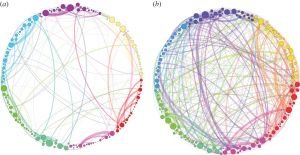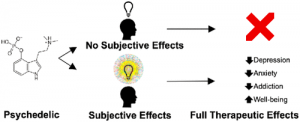Psychedelics
Psychedelics are exogenous neurotransmitters, that cause pivotal mental states inducing varying durations and intensity of neuroplasticity periods.
The mind is a neurochemical machine it has so many inputs it evolved the subconscious to stop too much noise overwhelming the system. The word Psychedelic means mind-manifesting, i.e. it is taking some of these subconscious inputs and opening it up to the conscious mind. They work like a switch, once present in the system they switch of the inhibitory system and systems become conscious. The effect is that millions of years of heuristics are opened up. Only those which were promoted to the conscious mind were accessible to you, now you can see what is under the hood. However, as we have a limited awareness i.e. processing power it is different to normal consciousness as all of the inputs which had been subdued are now switch on and you are only built to pay attention to one or two things at one time. So the experience is often incapacitating and thus makes us vulnerable. To deal with this the brain tries to find patterns and groups concepts into "icons", metaphorical symbols, which are being seen from a far. Many of these icons can be archetypal of general human consciousness or personal. Brain-Derived Neurotrophic Factor (BDNF) is thought to be a mediating factor in the neuroplasticity created during administration of psychedelics.[1]
Usage
Psychedelics are often incorrectly personified as doing good or bad, however in reality they are just tools, it is the intention behind their use that makes their effect. In a clinical sense, under specific priming and setting there is abundant evidence for the safety and efficacy for their use in:
- Ecological denialism - several studies have shown that psychedelic use leads to pronounce ecological concern[2][3][4]. It has been suggested that this may be because as perceptual frameworks dissolve, the rationality of common good between humans precipitates.
- Circular thought patterns
- Depression
- Obsessive compulsive disorder (OCD)
- Circular behavioural patterns
Psychedelic Compounds
There are 5 classes of psychedelics based upon their effect and chemistry.
Tryptamines
- Psilocybin / psilocin found in psilocybin mushrooms
- DMT found in acacias and ayahuasca
- 5-MeO-DMT found in toad venom
Ergoline
- LSD derived from ergot
Phenylethylamines
- Mescaline found in the peyote cactus
- MDMA synthetically made
- 2C-B synthetically made
Deliriants
- Muscimol found in amanita muscaria
- Ibogane
Dissociatives
- Ketamine synthetically made
Psychedelic Comparison
Whilst the pharmaceutical industry markets that psychedelics can cure everything from obesity to hair loss, in reality there is little evidence that they can treat any other conditions apart from mental health issues. In regards to mental health, Psilocybin, DMT and LSD have a very similar effect[7][8][9][10] whilst Phenylethylamines, Deliriants and Dissociatives whilst hallucinogenic have differing effects. Popular opinion, is that each psychedelic irrelevant of class has an individual nuanced effect, this can be seen by the thousands of subjective reports scattered on the internet https://erowid.org/experiences/). However, a recent analysis of 2947 publicly available trip reports concluded:
"MDMA experience reports featured an emotionally intensifying profile accompanied by many cognitive process words and dynamic-personal language. In contrast, Ayahuasca and DMT experience reports involved relatively little emotional language, few cognitive process words, increased analytical thinking-associated language, and the most semantic similarity with psychedelic and mystical experience descriptions[11]. LSD, psilocybin mushroom, and ketamine reports showed only small differences on the emotion-, analytical thinking-, psychedelic, and mystical experience-related language outcomes. Further research has concluded: “Both doses of LSD and the high dose of psilocybin produced qualitatively and quantitatively very similar subjective effects, indicating that alterations of mind that are induced by LSD and psilocybin do not differ beyond the effect duration”[8].
For psilocybin, ketamine, mescaline and LSD it has been found that the psychedelic experience have yielded magnetoencephalographic (MEG) signals values exceeding those of normal waking consciousness. Indicating psychedelic drugs induce ‘heightened state of consciousness‘. The scans found the most notable effects in parts of the brain that are known to be important for perceptions, rather than other roles such as language and movement.
Medicinal Chemistry
All psychedelics are chemically unique and but can be catergorised into four main main types (see figure 2). There are three main families of chemical compounds: tryptamines, phenethylamines, or lysergamides and many tend to act via serotonin 2A receptor agonism which plays a key role in regulation of cortical function. Serotonin antagonism has been proposed as the mechanism for the subjective and biological effects of classical psychedelics as these effects are blocked after administering 5HT2AR antagonists such as ketanserin[12][13].
Side effects
Mescaline causes stomach cramps.
Duration of psychedelic state
- DMT - 30 minutes.
- Psilocybin 3-6 hours.
- Ayahuasca 4-7 hours.
- LSD 6-11 hours.
Duration of effect
Emotions and brain function are altered up to one month after a single high dose of psilocybin[14].
Psychedelic Contraindications
Some medicines which are regularly taken for depression and anxiety are said to interact with psychedelics. Most notably the SSRI and psychedelic interaction.
Microdosing
The medical definition of microdosing is a dose given which is sub therapeutic, i.e. it is the dose doctors recognise as having no discernible effect. However, many claim, mainly via online survey studies, that very low doses of LSD, taken at 3–4-day intervals, improve mood and cognitive function[15].
In controlled studies, which in mental health are the gold standard, (see critical appraisal) the placebo effect is excluded. In all of these studies microdosing has been shown to have no effect[16] and even in some have shown negative effects such as neuroticism[17]. It has been suggested that this is because the experience of the trip is more important than the underlying chemical-electrical mechanisms[18] (see Figure 3) . By propagating the myth that microdosing does have an effect this may cause people from not accessing the correct dose and getting the actual benefit from the medicine.
References
- ↑ Psychedelics and Neuroplasticity: A Systematic Review Unraveling the Biological Underpinnings of Psychedelics Cato M. H. de Vos, Natasha L. Mason and Kim P. C. Kuypers* Department of Neuropsychology and Psychopharmacology, Faculty of Psychology and Neuroscience, Maastricht University, Maastricht, Netherlands Front. Psychiatry, 10 September 2021
- ↑ Manifesting Minds: A Review of Psychedelics in Science, Medicine, Sex, and Spirituality. Doblin, Rick; Brad Burge (2014) North Atlantic Books. ISBN 1583947272.
- ↑ Lifetime experience with (classic) psychedelics predicts pro-environmental behavior through an increase in nature relatedness. Matthias Forstmann and Christina Sagioglou Journal of Psychopharmacology 2017. DOI: 10.1177/0269881117714049
- ↑ From Egoism to Ecoism: Psychedelics Increase Nature Relatedness in a State-Mediated and Context-Dependent Manner. Hannes Kettner, Sam Gandy, Eline C. H. M. Haijen and Robin L. Carhart-Harris Centre for Psychedelic Research, Department of Brain Sciences, Faculty of Medicine, Imperial College London. International Journal of Environmental Research and Public Health. Published: December 2019 DOI: 10.3390/ijerph16245147
- ↑ A Radical New Approach to Beating Addiction". Psychology Today. Retrieved February 24, 2019, also Francis Hartigan Bill Wilson p. 177-179.
- ↑ An online survey of tobacco smoking cessation associated with naturalistic psychedelic use. Journal of Psychopharmacology, 31(7), 841–850. Johnson, M. W., Garcia-Romeu, A., Johnson, P. S., & Griffiths, R. R. (2017). doi:10.1177/0269881116684335 10.1177/0269881116684335
- ↑ Effects of Naturalistic Psychedelic Use on Depression, Anxiety, and Well-Being: Associations With Patterns of Use, Reported Harms, and Transformative Mental States. Front. Psychiatry, 15 March 2022. Sec. Psychopharmacology. https://doi.org/10.3389/fpsyt.2022.831092
- ↑ 8.0 8.1 Direct comparison of the acute effects of lysergic acid diethylamide and psilocybin in a double-blind placebo-controlled study in healthy subjects. Holze, F., Ley, L., Müller, F. et al. Neuropsychopharmacol. 47, 1180–1187 (2022). https://doi.org/10.1038/s41386-022-01297-2
- ↑ Double-blind comparison of the two hallucinogens psilocybin and dextromethorphan: similarities and differences in subjective experiences. Carbonaro TM, Johnson MW, Hurwitz E, Griffiths RR. Psychopharmacology (Berl). 2018 Feb;235(2):521-534. doi: 10.1007/s00213-017-4769-4. Epub 2017 Nov 7. PMID: 29116367; PMCID: PMC6645364.
- ↑ Comparison of the Reactions Induced by Psilocybin and LSD-25 in Man. From the National Institute of Mental Health, Addiction Research Center, U. S. Public Health Service, Lexington, Kentucky by HARRIS ISBELL 1959
- ↑ Analysis of recreational psychedelic substance use experiences classified by substance. Adrian Hase, Max Erdmann, Verena Limbach & Gregor Hasler Psychopharmacology volume 239, pages643–659 (2022) Altmetric Metrics https://link.springer.com/article/10.1007/s00213-022-06062-3
- ↑ Preller KH, Herdener M, Pokorny T, Planzer A, Kraehenmann R, Stämpfli P, et al. The Fabric of Meaning and Subjective Effects in LSD-Induced States Depend on Serotonin 2A Receptor Activation. Curr Biol. 2017 Feb;27(3):451–7.
- ↑ Ly C, Greb AC, Cameron LP, Wong JM, Barragan EV, Wilson PC, et al. Psychedelics Promote Structural and Functional Neural Plasticity. Cell Rep. 2018 Jun 12;23(11):3170–82.
- ↑ Emotions and brain function are altered up to one month after a single high dose of psilocybin. Barrett, F.S., Doss, M.K., Sepeda, N.D. et al. Sci Rep 10, 2214 (2020). https://doi.org/10.1038/s41598-020-59282-y
- ↑ Prochazkova, L., Lippelt, D.P., Colzato, L.S. et al. Exploring the effect of microdosing psychedelics on creativity in an open-label natural setting. Psychopharmacology 235, 3401–3413 (2018). https://doi.org/10.1007/s00213-018-5049-7
- ↑ Repeated low doses of LSD in healthy adults: A placebo-controlled, dose–response study Harriet de Wit,Hanna M. Molla,Anya Bershad,Michael Bremmer,Royce Lee First published: 01 February 2022 https://doi.org/10.1111/adb.13143https://onlinelibrary.wiley.com/doi/abs/10.1111/adb.13143
- ↑ A Systematic Study of Microdosing. Richard J. Stevenson, Macquarie University, Sydney, Australia. 10.1371/journal.pone.0211023
- ↑ The Subjective Effects of Psychedelics Are Necessary for Their Enduring Therapeutic Effects: David B. Yaden and Roland R. Griffiths* ACS Pharmacol. Transl. Sci. 2021, 4, 2, 568–572. Publication Date:December 10, 2020. https://doi.org/10.1021/acsptsci.0c00194


